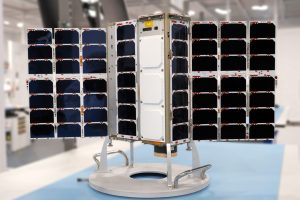Northumbria University is collaborating with Lockheed Martin for research into the role played by ‘nanojets’ and the reconnection of the Sun’s magnetic field lines for generating the Solar Corona’s heat. In a bid to gather more evidence about how often nanojets occur and how they impact coronal heating, Northumbria PhD student Ramada Sukarmadji, under the supervision of Dr Patrick Antolin, ...
Military/Aerospace Electronics
Electronics related to Military/Aerospace
A fiery end to Aeolus, and its Chelmsford-made image sensor
ESA has begun the controlled destruction of its Aeolus global wind-measuring satellite. Launched in 2018, the 1.3 tonne satellite has already worked 18 months longer than its planned three year mission, but is now running out of orbit-maintaining fuel. Matter and radiation released by recent solar flares and coronal mass ejections have temporarily increased drag in space, and ESA is ...
Space mission sees XCAM imaging thermospheric winds impacting GPS
XCAM is collaborating with UCAR (University Corporation for Atmospheric Research) to observe the global thermospheric winds that impact radio and GPS communications. The space mission – dubbed WindCube – will involve the first wind measuring interferometer to be carried on a small 6-U LEO CubeSat, with XCAM providing an advanced imaging camera system. The Northampton-based company designs and manufactures highly ...
OroraTech signs Spire for eight-satellite wildfire detection constellation
Spire Global, the space services company with offices in Glasgow, has signed an agreement with OroraTech, a specialist in space-based thermal intelligence, to build, launch and operate an eight-satellite constellation. The constellation is described as the first dedicated to tracking and monitoring wildfires. Once operational, it will feature real-time detection capability, continuous situational awareness and predictive insights to help detect ...
36 e2v sensors on ESA’s Euclid space mission
The Teledyne e2v team designed and manufactured the 36 sensors for the visible wavelength camera on the Euclid spacecraft, due to be launched on Saturday, which aims to determine the properties of dark energy and dark matter. Euclid is designed to explore the evolution of the dark universe. Over six years, it will make a 3D-map of the universe by ...
Safran, Terran sign MOA for U.S. satellite electric propulsion system
Safran Electronics & Defense and Terran Orbital have signed a Memorandum of Agreement to study the production of a new electric propulsion system – based on Safran’s PPSX00 plasma thruster – for LEO satellites. The aim, they say, is to make spacecraft more resilient and maneuverable at faster delivery rates and lower costs, for both governmental and commercial customers. And ...
Leonardo returns to STEM Returners for diverse job applicants across the UK
Leonardo is bidding to make engineering roles more accessible to diverse job applicants across the UK, through a collaboration with STEM Returners. Following a successful pilot programme, the company is scaling up the inititative to hire 25 “returners” before October. Open to all, it presents a chance to move into a career with Leonardo in engineering roles spanning systems, software, ...
UK Space Agency provides £2.1m funding for UK spaceflight capabilities
The UK government is providing £2.1 million of funding, through the UK Space Agency (UKSA), to boost UK-based involvement in space technologies such as harnessing solar power for reusable spacecraft and new propulsion systems. The initial nine projects involve work at Lancaster University, the Surrey Space Centre at the University of Surrey, Swansea University, University of Strathclyde, Durham University (two ...
Intelsat starts monitoring rush-hour pollution for NASA
Intelsat, the satellite comms and inflight connectivity specialist, has begun monitoring air pollution above America on behalf of NASA. Specifically, the company has powered up the first space-based instrument to monitor major air pollutants across North America and send data back to earth as part of the first phase of in-orbit testing, it reports. The UV-visible spectrometer, operated by Intelsat ...
Skyrora 3D prints new model of 70kN rocket engine, starts full-duration tests
As preparation for a commercial launch, Skyrora has 3D printed a new model of its orbital rocket engine ready for landmark tests. The Edinburgh-based rocket company – which has developed its own eco-friendly fuel, Ecosene, made of waste plastics – has begun a series of full-duration tests to qualify the updated design of its 70kN engine. The engines were created ...
 Electronics Weekly Electronics Design & Components Tech News
Electronics Weekly Electronics Design & Components Tech News









